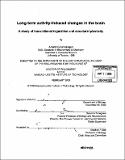Long-term activity-induced changes in the brain : a study of translational regulation and structural plasticity
Author(s)
Govindarajan, Arvind
DownloadFull printable version (8.827Mb)
Other Contributors
Massachusetts Institute of Technology. Dept. of Biology.
Advisor
Susumu Tonegawa.
Terms of use
Metadata
Show full item recordAbstract
Long-lasting changes must take place in the brain to store the skills and memories that have been learned by the organism throughout its history. Long-term memory (LTM), and its cellular correlate, the late-phase of long-term potentiation (L-LTP), require protein synthesis. It has generally been assumed that the regulation of transcription underlies L-LTM and LTM. Chapter 2 of this thesis demonstrates that transgenic mice with inhibited ERK MAP Kinase pathway activity in the cortex and CA1 region of the hippocampus show inhibited LTM and L-LTP. Moreover, the L-LTP phenotype resembles a deficit in translation and not transcription. Experiments using hippocampal cultured cells demonstrate that neuronal activity induces translation of a large number of mRNAs in an ERK MAP Kinase pathway-dependent manner via phosphorylation of the translation factors S6, elF4E and 4E-BP1. Increased phosphorylation of translation factors was observed along with increased translation after the induction of L-LTP; lastly, LTM formation occurred concomitantly with ERK MAP Kinase pathway-dependent phosphorylation of S6 and elF4E. Chapter 3 extends these findings to demonstrate that other stimuli that cause protein synthesis-dependent forms of plasticity also upregulate protein synthesis via the same mechanisms. (cont.) As some of these stimuli cause L-LTP and others cause L-LTD, it is proposed that induction of these forms of plasticity, though opposite in terms of synaptic-weight changes, produce the same proteins, and that activated synapses capture the appropriate proteins to express the appropriate form of synaptic plasticity. Cellularly, it is believed that these long-lasting changes involve structural plasticity in the neurons. However, as it has generally been difficult to show such a correlation between structural changes and behavioral changes after behavioral training, a correlation between structural changes and affective behaviors after chronic-stress treatment was sought. Chapter 4 shows that transgenic mice overexpressing BDNF only in forebrain pyramidal cells have reduced chronic stress-induced atrophy in the apical dendrites of CA3 pyramidal cells. This structural change is correlated with improved performance in the Porsolt forced-swim test. Increased spinogenesis was observed in the amygdala concomitantly with an increase in anxiety, thus demonstrating a strong correlation between structural change and behavior.
Description
Thesis (Ph. D.)--Massachusetts Institute of Technology, Dept. of Biology, February 2005. Vita. Includes bibliographical references.
Date issued
2005Department
Massachusetts Institute of Technology. Department of BiologyPublisher
Massachusetts Institute of Technology
Keywords
Biology.